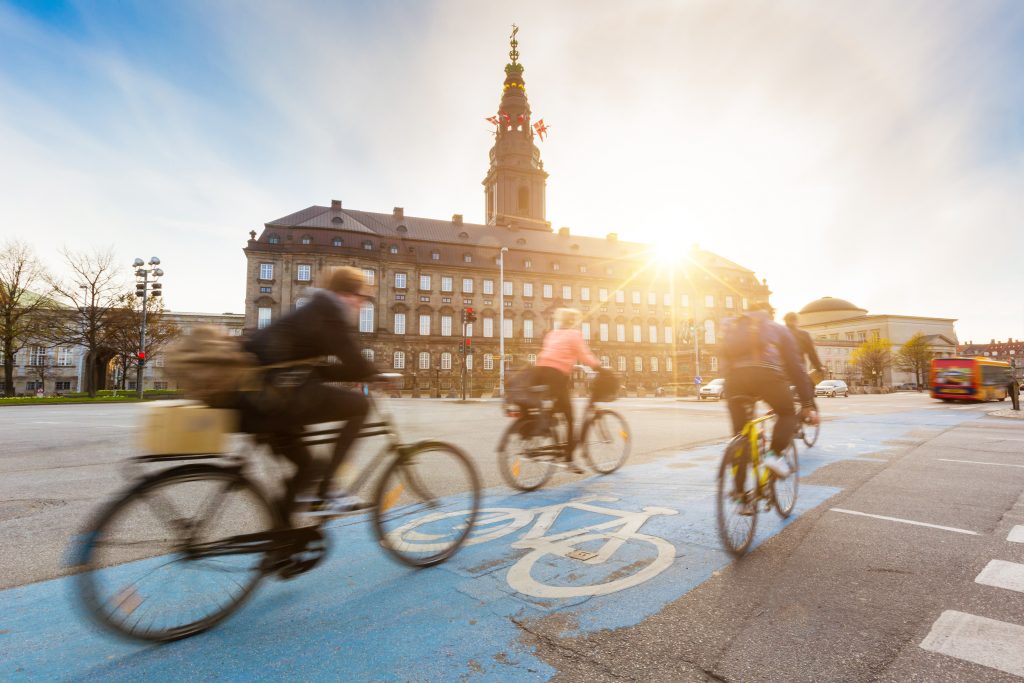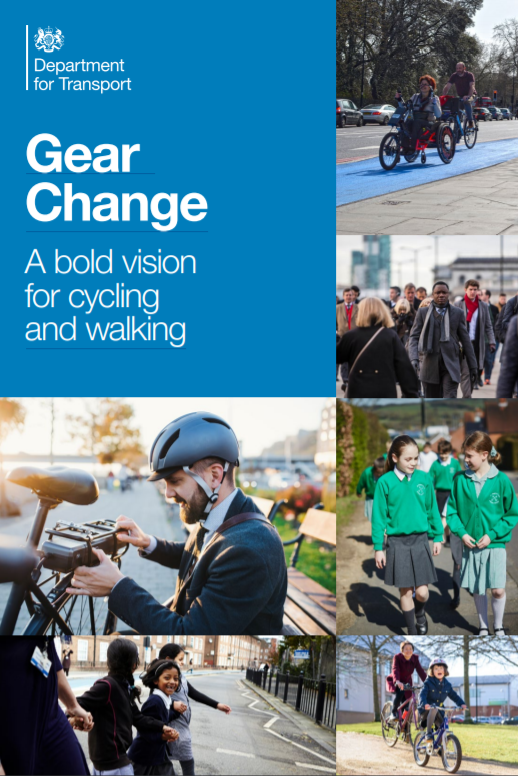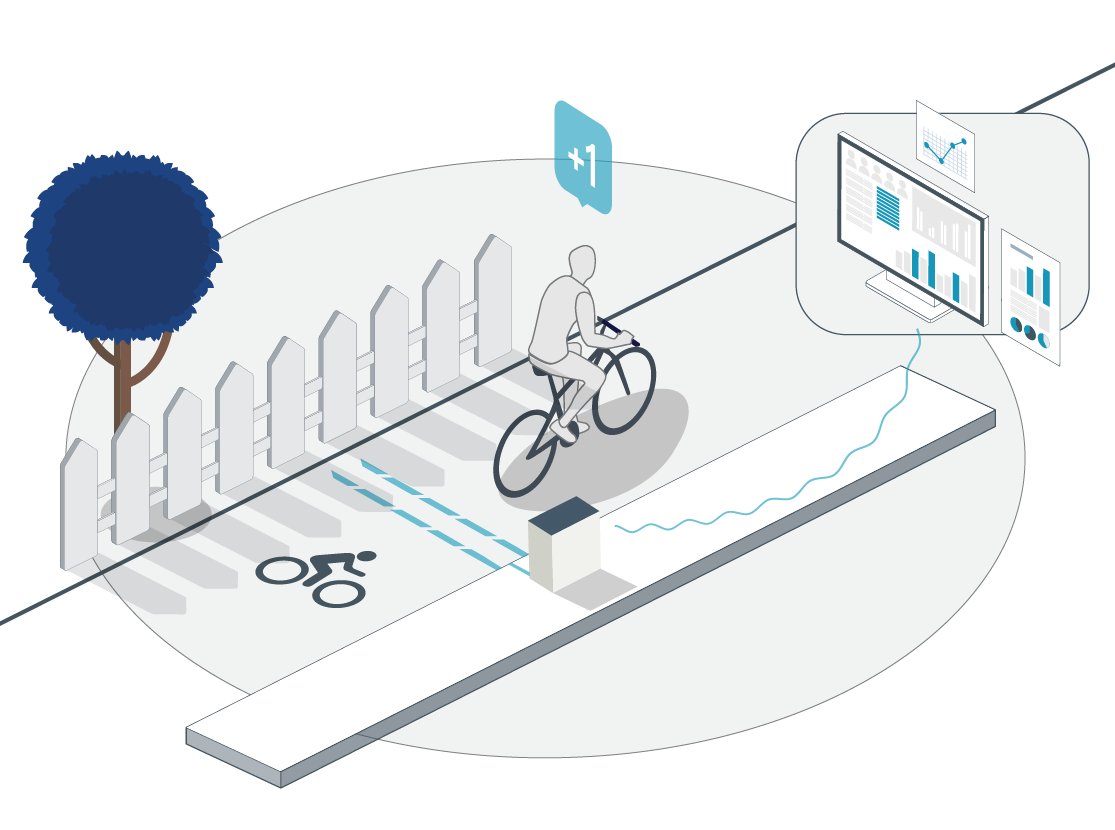Innovative, sustainable and experienced

DOWNLOAD GEAR CHANGE
“We want – and need – to see a step-change in cycling and walking in the coming years. The challenge is huge, but the ambition is clear. We have a unique opportunity to transform the role cycling and walking can play in our transport system, and get England moving differently”
From Gear change – for A bold vision for cycling and walking. /Department for Transportation
Active Travel
Active travel refers to any form of human-powered transportation that involves physical activity for the purpose of making everyday journeys. It includes modes of transportation such as walking, cycling, and scootering, where individuals use their own physical energy to move from one place to another, instead of relying on motorised vehicles like cars or buses.
Building walking and cycling into our daily routines are the most effective ways to increase physical activity. Shifting more journeys to active travel not only improve health, quality of life and the environment, but at the same time reducing costs to the taxpayer.
Active travel enables optimal travel to work with reduced traffic congestion, improved air quality, lower carbon emissions, less collisions and road casualties and an improved quality of life.
The government has recently announced funding to help councils develop miles of footways and cycle paths while enhancing crossings and junctions for improved safety. To secure these funds, local authorities must submit a business case demonstrating how their proposed schemes align with key criteria, including safety, accessibility, sustainability, community engagement, and cost-effectiveness.
At TagMaster, we provide innovative multi-sensor systems designed for all environments, enabling councils to collect the key data needed to develop and implement successful active travel schemes.
Our active travel solutions support a wide range of applications, including before-and-after surveys, permanent monitoring, temporary and seasonal campaigns, and multimodal data collection.
These include:
The CityRadar counter, a non-intrusive counter, collects reliable and accurate cycle-pedestrian data. It can be deployed easily, quickly and safely, with no need for in-ground sensors or civil engineering.
Its adaptability means it can be deployed on existing street furniture, making it easy to move around. It can be battery-powered for short-term surveys but can also be installed permanently or semi permanently thanks to its solar-powered or mains-powered capability.
The CompactPLUS Cycle and Pedestrian unit utilises in-ground sensors (loops or piezo) and an IR sensor to collect vital and highly granular data on usage patterns, including classified volumes and peak times.
Completely autonomous, it will help local authorities monitor micromobility in urban and rural areas by accurately detecting and classifying cycles, cargo bikes, scooters, mopeds and pedestrians.
TrafficStatistics is a software solution using Artificial Intelligence and Deep Learning technology to collect highly accurate Multimodal data (Pedestrians, cycles, scooters, motorbikes, cars, LGV, HGV and buses).
This non-intrusive solution can be used with new or existing cameras and works in all traffic conditions (dedicated or mixed traffic lanes, free-flowing or congested traffic, etc.).
Background
An announcement was made by the Government that millions of people across the country are set to benefit from £200 million of government funding for cycling and walking schemes, helping to promote healthy travel, reduce emissions and grow the economy.
The latest round of funding, will provide a boost to high streets and local businesses, and transform the school run for tens of thousands of children, generating up to 16 million extra walking and cycling trips a year.
Growing interest on the benefits of non-motorised travel has increased the demand for accurate and timely pedestrian and bicycle travel data. Pedestrian & bicycle traffic monitoring is essential to comprehend current figures and for planning and predicting future demand to manage cycling infrastructure.
As more and more people shift towards Active Travel as their preferred method of transport, it becomes essential to incorporate these active travel modes into transportation planning.
Well-designed, accessible streets and improved cycle infrastructure can encourage people to walk or cycle more as part of their daily routines, leading to a healthier lifestyle.
Data collected by TagMaster’s bicycle and pedestrian counting technology can be used by transport planners to make informed decisions. The data can also help justify investments and measure the success of an active transportation policy.
Since 2022, Transport for London (TfL) & Google Maps have collaborated to make cycling safer in Cities. The partnership will see Google update its algorithms using TfL traffic data to help cyclists prioritise cycling on safer, quieter roads and make them easier to locate within Google Maps. Cycling updates to Google Maps will now include traffic conditions and the availability of high-quality cycling infrastructure.
TfL and the London boroughs have produced more than 340km of cycle routes in London, however existing digital journey planners do not always take these into account and therefore do not always provide the most suitable route for cycling.
Google has worked with TfL’s Open Innovation team and TfL’s industry-leading experts to help solve some of the problems presented and ultimately improve cycle routing in Google Maps. (Source: TrafficTechnologyToday.com)
Traffic Data can be collected using TagMaster’s Active Travel monitoring solutions. Highly accurate and flexible systems, perfect for obtaining trends over time and allows for the comparison of trends over consecutive months, seasons, or years. Real-time communication provides instant data to allow users to understand the potential impact on services and infrastructure.
Gear Change
TagMaster support the Governments ‘Gear Change’ strategy to radically change our transport networks across the UK to include thousands of miles of protected bike lanes, so anyone can ride safely in low-traffic neighbourhoods, to stop rat-running and make it easier to walk and cycle.
The Government want – and need – to see a step-change in cycling and walking in the coming years. The challenge is huge, but the ambition is clear. There is a unique opportunity to transform the role cycling and walking can play in our transport system, and get England moving differently.
Increasing cycling and walking can help tackle some of the most challenging issues we face as a society – improving air quality, combatting climate change, improving health and wellbeing, addressing inequalities and tackling congestion on our roads.
“To make England an active travel nation, we need to take action to tackle the main barriers. We need to attract people to active travel by building better quality infrastructure, making streets better for everyone, and we need to make sure people feel safe and confident cycling. To deliver this, we need to ensure active travel is embedded in wider policy making and want to encourage and empower local authorities to take bold decisions.”
As part of the summary principles for cycle infrastructure design, the guidance suggest trials of cycle route can be created. Trials can help achieve change and ensure a permanent scheme is right first time. This will avoid spending time, money and effort modifying a scheme that does not perform as anticipated. If there is dispute about the impact of a road change, we recommend trialling it with temporary materials. If it works, it can be made permanent through appropriate materials. If it does not, it can be easily and quickly removed or changed. However, it is important that the scheme is designed correctly at the beginning, to maximise the chances of it working.
TagMaster’s Active Travel monitoring systems can help manage and report on these trials by collecting data using TagMaster’s bicycle and pedestrian counting technology to report on the number of users. This will help cycle scheme designers make informed decisions as to whether the planned investment into the cycle infrastructure is justified.
Benefits of Active Travel
Active travel has numerous health, environmental, social and economic benefits.
Physical Health: Walking, cycling, and other forms of active travel provide cardiovascular benefits, help in weight management, and improve overall fitness.
Mental Health: Regular physical activity, including walking and cycling, is linked to reduced stress, anxiety, and depression. It also enhances mental clarity and overall cognitive function.
Environmental Impact: Active travel produces zero emissions, making it an eco-friendly alternative to driving, which helps reduce air pollution and combat climate change.
Supports Decarbonisation: Active travel will help reduce its carbon footprint, in order to reduce its impact on the climate.
Cost-Effective: Walking and cycling are cost-free modes of transportation. Even with initial investment in bicycles or walking gear, the long-term cost is significantly lower compared to owning and maintaining a car.
Community Interaction: Active travel encourages social interactions. People walking or cycling tend to engage more with their surroundings and with other pedestrians and cyclists, fostering a sense of community.
Economic growth and vibrant communities: Investing in infrastructure and support for active travel can increase economic growth and vibrancy. Those walking, wheeling and cycling tend to spend more money locally than drivers. Increasing active travel can stimulate economic growth in urban areas and benefit local shops.
Traffic Reduction: Increased active travel can help reduce congestion on roads, making urban areas more liveable and less stressful for everyone.
Improved Infrastructure: The promotion of active travel often leads to better infrastructure like bike lanes and pedestrian-friendly pathways, which benefits the overall urban environment.
Reduced Dependence on Fossil Fuels: By reducing the reliance on cars, active travel contributes to the conservation of fossil fuels.
Many cities and urban areas are investing in infrastructure and policies to encourage active travel, recognising its multiple benefits for individuals and communities alike.
Monitoring Solutions
TagMaster Traffic Monitoring solutions for Active Travel bicycle and pedestrian counting, provide highly accurate data, perfect for obtaining trends over time. Modes of transport can be distinguished from cycle, prams, trolleys, motorbikes, scooters and pedestrians. These data insights can help transport planners make informed decisions.



